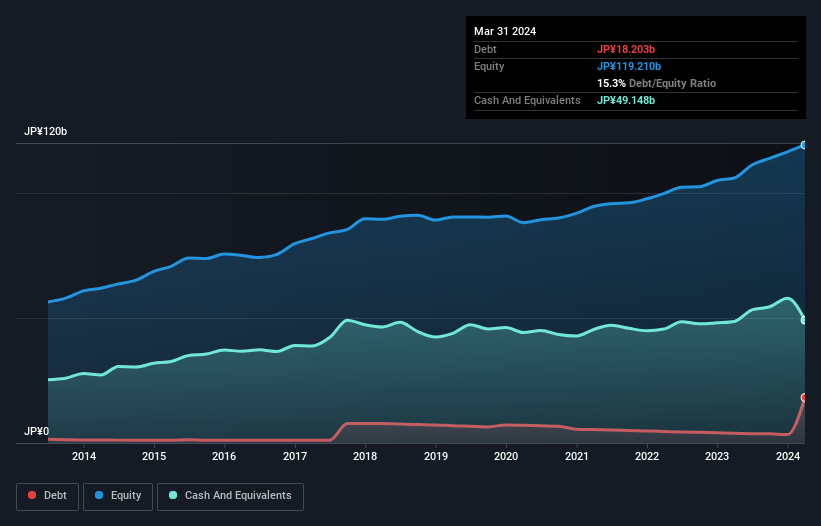
David Iben put it well when he said, 'Volatility is not a risk we care about. What we care about is avoiding the permanent loss of capital.' It's only natural to consider a company's balance sheet when you examine how risky it is, since debt is often involved when a business collapses. We can see that Mitsubishi Pencil Co., Ltd. (TSE:7976) does use debt in its business. But the real question is whether this debt is making the company risky.
When Is Debt A Problem?
Generally speaking, debt only becomes a real problem when a company can't easily pay it off, either by raising capital or with its own cash flow. Part and parcel of capitalism is the process of 'creative destruction' where failed businesses are mercilessly liquidated by their bankers. However, a more frequent (but still costly) occurrence is where a company must issue shares at bargain-basement prices, permanently diluting shareholders, just to shore up its balance sheet. Of course, debt can be an important tool in businesses, particularly capital heavy businesses. When we think about a company's use of debt, we first look at cash and debt together.
View our latest analysis for Mitsubishi Pencil
What Is Mitsubishi Pencil's Net Debt?
As you can see below, at the end of March 2024, Mitsubishi Pencil had JP¥18.2b of debt, up from JP¥3.92b a year ago. Click the image for more detail. However, it does have JP¥49.1b in cash offsetting this, leading to net cash of JP¥30.9b.

How Strong Is Mitsubishi Pencil's Balance Sheet?
We can see from the most recent balance sheet that Mitsubishi Pencil had liabilities of JP¥37.4b falling due within a year, and liabilities of JP¥12.3b due beyond that. Offsetting this, it had JP¥49.1b in cash and JP¥19.7b in receivables that were due within 12 months. So it can boast JP¥19.1b more liquid assets than total liabilities.
This surplus suggests that Mitsubishi Pencil has a conservative balance sheet, and could probably eliminate its debt without much difficulty. Simply put, the fact that Mitsubishi Pencil has more cash than debt is arguably a good indication that it can manage its debt safely.
Another good sign is that Mitsubishi Pencil has been able to increase its EBIT by 23% in twelve months, making it easier to pay down debt. When analysing debt levels, the balance sheet is the obvious place to start. But it is future earnings, more than anything, that will determine Mitsubishi Pencil's ability to maintain a healthy balance sheet going forward. So if you're focused on the future you can check out this free report showing analyst profit forecasts.
Finally, a business needs free cash flow to pay off debt; accounting profits just don't cut it. While Mitsubishi Pencil has net cash on its balance sheet, it's still worth taking a look at its ability to convert earnings before interest and tax (EBIT) to free cash flow, to help us understand how quickly it is building (or eroding) that cash balance. During the last three years, Mitsubishi Pencil produced sturdy free cash flow equating to 71% of its EBIT, about what we'd expect. This free cash flow puts the company in a good position to pay down debt, when appropriate.
Summing Up
While it is always sensible to investigate a company's debt, in this case Mitsubishi Pencil has JP¥30.9b in net cash and a decent-looking balance sheet. And it impressed us with its EBIT growth of 23% over the last year. So we don't think Mitsubishi Pencil's use of debt is risky. Above most other metrics, we think its important to track how fast earnings per share is growing, if at all. If you've also come to that realization, you're in luck, because today you can view this interactive graph of Mitsubishi Pencil's earnings per share history for free.
At the end of the day, it's often better to focus on companies that are free from net debt. You can access our special list of such companies (all with a track record of profit growth). It's free.
New: Manage All Your Stock Portfolios in One Place
We've created the ultimate portfolio companion for stock investors, and it's free.
• Connect an unlimited number of Portfolios and see your total in one currency
• Be alerted to new Warning Signs or Risks via email or mobile
• Track the Fair Value of your stocks
Have feedback on this article? Concerned about the content? Get in touch with us directly. Alternatively, email editorial-team (at) simplywallst.com.
This article by Simply Wall St is general in nature. We provide commentary based on historical data and analyst forecasts only using an unbiased methodology and our articles are not intended to be financial advice. It does not constitute a recommendation to buy or sell any stock, and does not take account of your objectives, or your financial situation. We aim to bring you long-term focused analysis driven by fundamental data. Note that our analysis may not factor in the latest price-sensitive company announcements or qualitative material. Simply Wall St has no position in any stocks mentioned.
About TSE:7976
Mitsubishi Pencil
Manufactures and supplies writing instruments in Japan.
Undervalued with excellent balance sheet and pays a dividend.
Market Insights
Community Narratives



